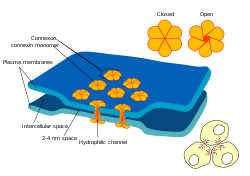| Electrical synapse | |
|---|---|
 Diagram of a gap junction | |
| Identifiers | |
| MeSH | D054351 |
| TH | H1.00.01.1.02024 |
| FMA | 67130 |
| Anatomical terminology | |
An electrical synapse, or gap junction, is a mechanical and electrically conductive synapse, a functional junction between two neighboring neurons. The synapse is formed at a narrow gap between the pre- and postsynaptic neurons known as a gap junction. At gap junctions, such cells approach within about 3.8 nm of each other,[1] a much shorter distance than the 20- to 40-nanometer distance that separates cells at a chemical synapse.[2] In many[specify] animals, electrical synapse-based systems co-exist with chemical synapses.
Compared to chemical synapses, electrical synapses conduct nerve impulses faster and provide continuous-time bidirectional coupling via linked cytoplasm.[1][3][4][5] As such, the notion of signal directionality across these synapses is not always defined.[5] They are known to produce synchronization of network activity in the brain[6] and can create chaotic network level dynamics.[7][8] In situations where a signal direction can be defined, they lack gain (unlike chemical synapses)—the signal in the postsynaptic neuron is the same or smaller than that of the originating neuron [citation needed]. The fundamental bases for perceiving electrical synapses comes down to the connexons that are located in the gap junction between two neurons. Electrical synapses are often found in neural systems that require the fastest possible response, such as defensive reflexes. An important characteristic of electrical synapses is that they are mostly bidirectional, allowing impulse transmission in either direction.[9][10]
- ^ a b Kandel, ER; Schwartz, JH; Jessell, TM (2000). Principles of Neural Science (4th ed.). New York: McGraw-Hill. ISBN 978-0-8385-7701-1.
- ^ Hormuzdi SG, Filippov MA, Mitropoulou G, Monyer H, Bruzzone R (March 2004). "Electrical synapses: a dynamic signaling system that shapes the activity of neuronal networks". Biochim. Biophys. Acta. 1662 (1–2): 113–37. doi:10.1016/j.bbamem.2003.10.023. PMID 15033583.
- ^ Purves, Dale; Williams, Stephen Mark, eds. (2004). Neuroscience (3rd ed.). Sunderland, Mass: Sinauer Associates. ISBN 978-0-87893-915-2.
- ^ Bennett, M. V. L. (1966). "PHYSIOLOGY OF ELECTROTONIC JUNCTIONS*". Annals of the New York Academy of Sciences. 137 (2): 509–539. doi:10.1111/j.1749-6632.1966.tb50178.x. ISSN 0077-8923.
- ^ a b Connors, Barry W.; Long, Michael A. (2004-07-21). "ELECTRICAL SYNAPSES IN THE MAMMALIAN BRAIN". Annual Review of Neuroscience. 27 (1): 393–418. doi:10.1146/annurev.neuro.26.041002.131128. ISSN 0147-006X.
- ^ Bennett, Michael V.L; Zukin, R.Suzanne (2004). "Electrical Coupling and Neuronal Synchronization in the Mammalian Brain". Neuron. 41 (4): 495–511. doi:10.1016/S0896-6273(04)00043-1.
- ^ Makarenko, Vladimir; Llinás, Rodolfo (1998-12-22). "Experimentally determined chaotic phase synchronization in a neuronal system". Proceedings of the National Academy of Sciences. 95 (26): 15747–15752. doi:10.1073/pnas.95.26.15747. ISSN 0027-8424. PMC 28115. PMID 9861041.
- ^ Korn, Henri; Faure, Philippe (2003-09-01). "Is there chaos in the brain? II. Experimental evidence and related models". Comptes Rendus. Biologies. 326 (9): 787–840. doi:10.1016/j.crvi.2003.09.011. ISSN 1768-3238.
- ^ Purves, Dale; George J. Augustine; David Fitzpatrick; William C. Hall; Anthony-Samuel LaMantia; James O. McNamara & Leonard E. White (2008). Neuroscience (4th ed.). Sinauer Associates. pp. 85–88. ISBN 978-0-87893-697-7.
- ^ Purves, Dale; George J. Augustine; David Fitzpatrick; William C. Hall; Anthony-Samuel LaMantia; Richard D. Mooney; Leonard E. White & Michael L. Platt (2018). Neuroscience (6th ed.). Oxford University Press. pp. 86–87. ISBN 978-1605353807.